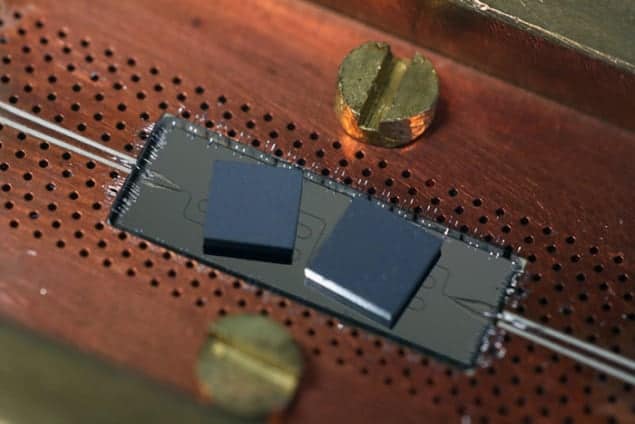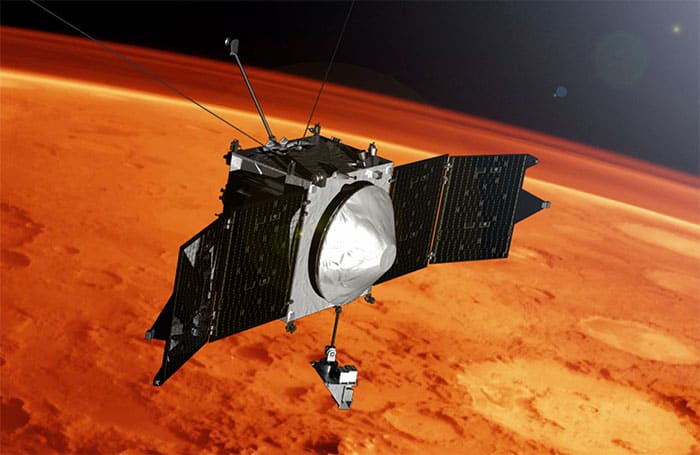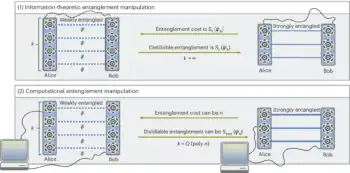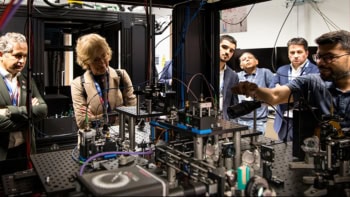Flash Physics is our daily pick of the latest need-to-know developments from the global physics community selected by Physics World‘s team of editors and reporters

Quantum diamonds coupled using microwaves
Nitrogen-vacancy (NV) centres on two different diamonds have been coupled coherently by physicists in Austria. NV centres occur whenever two neighbouring carbon atoms in diamond are replaced by a nitrogen atom and an empty lattice site. NV centres are being used to develop quantum technologies because they have spin states with very long quantum-coherence times, even at room temperature. Another important benefit of NV centres is that they interact with both light and microwave radiation and could therefore act as a transducer between quantum devices based on the two types of radiation. Now, Johannes Majer and colleagues at the Technical University of Vienna have created quantum-coherent interactions between NV centres in two different pieces of diamond separated by about 5 mm. The diamonds are placed on two different microwave cavities, which are connected by a microwave-resonator transmission line. A static magnetic field is applied to the system and this tunes the transition energies of the NV spins to correspond to the microwave energy of the cavity – causing the NV spins to couple to the cavity. Because microwave radiation can travel through the transmission line between the two cavities, the NV centres in both diamonds can be coupled to each other. The team showed that when the crystalline structures of both diamonds are aligned, then the NV centres in both diamonds are coupled in a quantum-coherent manner. “This interaction is mediated by the microwave resonator in the chip in between; here, the resonator plays a similar role to that of a data bus in a regular computer,” says Majer. The coupling can also be switched off, allowing the NV centres of each diamond to be manipulated independently. While the researchers were not able to show that the NV centres on different diamonds were entangled quantum-mechanically, they write in Physical Review Letters that achieving and measuring entanglement could be an “interesting future challenge”.
Martian metals unlike Earth’s

Metal ions in Mars’ atmosphere have been directly detected for the first time, and the distributions are distinctly different to those on Earth. Scientists have extensive knowledge of Earth’s ionosphere – a region of high-energy electrons, ions and charged molecules in the upper atmosphere, resulting from the ionization of meteorite dust entering at high speed. Due to Earth’s magnetic fields, gravity and ionospheric winds, the metallic ions – mainly magnesium (Mg+) and iron (Fe+) – are forced into layers. Investigations into the ionospheres of other planets have been modelled upon Earth’s example and have been reliant upon indirect measurements from Earth or satellites. But now, NASA‘s Mars Atmosphere and Volatile Evolution (MAVEN) mission has not only made the first direct detection of ions on a planet other than Earth, but also found that they behave differently. MAVEN’s spectrometer has detected sodium (Na+), Mg+ and Fe+ continuously over the last two years, implying the ions are a permanent feature. But rather than Earth’s distinct layers, there is no separation of the light Mg+ and the heavy Fe+ with increasing altitude as expected because of gravity. Instead the metals are mixed with the neutral atmosphere at altitudes where no mixing process is expected. Joseph Grebowsky of NASA’s Goddard Space Flight Center in the US and team suggest this is because Mars only has localized magnetic fields in certain regions of the crust and so layering only occurs there. The aim of the MAVEN mission is to investigate how Mars lost most of its air, and the new results, published in Geophysical Research Letters give a new insight into predicting the atmospheres of other planets.
Canadian science panel calls for increased spending
Canadian science requires a billion dollar increase to avoid falling behind other nations in basic science. That is the main conclusion of a report released yesterday by a nine-strong panel led by David Naylor, former president of the University of Toronto, which also included the Nobel laureate Art McDonald and Blackberry co-founder Mike Lazaridis. The panel say that Canada needs to invest an additional C$1.3bn over the next four years to boost the science base – taking the county’s science budget to C$4.8bn – recommending that about C$500m of that increase should be diverted to basic research. The panel also calls on the government to set up a National Advisory Council on Research and Innovation that would advise the Canadian government on research priorities and also “provide broad oversight of the federal research and innovation ecosystem”. The Fundamental Science Review was commissioned last year by science minister Kirsty Duncan to review the state of science in Canada. The publication of the report comes after the Canadian government disappointed scientists last month with a flat budget for science in 2017.
- You can find all our daily Flash Physics posts in the website’s news section, as well as on Twitter and Facebook using #FlashPhysics. Tune in to physicsworld.com later today to read today’s extensive news story on a $12 sensor that can weigh microgram-sized objects.



